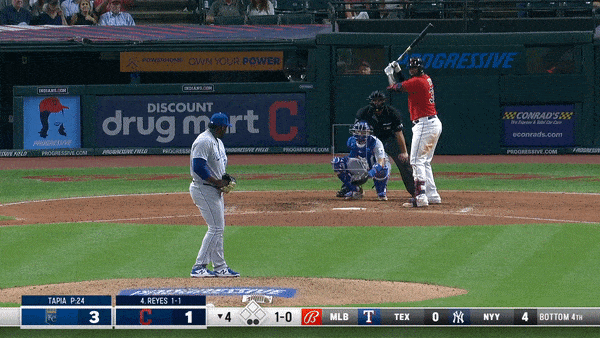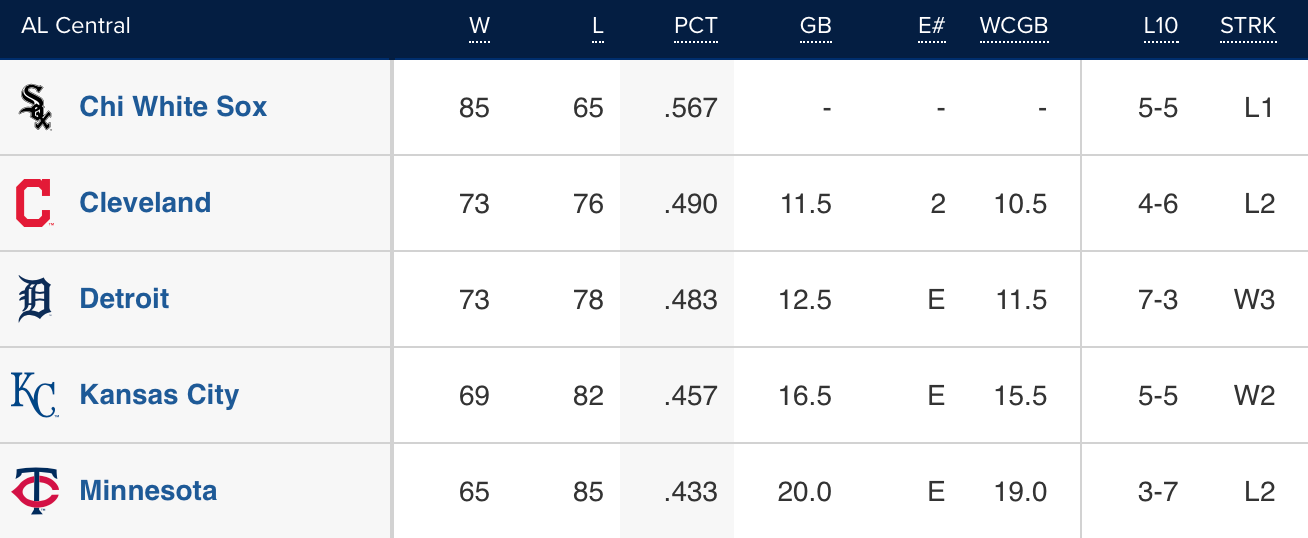Grab the brooms, the Royals are sweeping up the doubleheader in Cleveland
Singer shoves and so does the bullpen. Salvador Perez bombs his way into the record book. And the Royals finally pick up some wins against their Central Division nemesis.
Just in pure baseball terms, what we saw on Monday afternoon and evening was certainly unexpected.
The Royals rolled into Cleveland and made themselves right at home against a club that had been extremely inhospitable towards them in 2021. They swept the doubleheader winning the first game 7-2 and taking the nightcap by a final of 4-2.
Singer hits the right notes
Speaking of unexpected performances, how about Brady Singer? There’s no way manager Mike Matheny would say this part out loud, but there had to be a part of him that was terrified at what could unfold with Singer on the mound in the first game of a doubleheader with pitching plans for game two that could charitably be described as “unclear.” And all Singer did was shove, throwing all seven innings, striking out seven with the two runs coming in the fifth when the Royals had already staked him to a seven-run lead.
Quick aside: Can we please dispense with the talk that Singer pitched a complete game? Or come up with a new column on Baseball-Reference for a “Manfred complete game”? If a pitcher keeps the opposition hitless for one of these seven-inning games, but can’t get credit for a no-hitter, how in the world can one record a complete game?
Although, in his brief major league career, it sure seems like Singer is a dude built for a seven-inning complete game. In his 38 starts over two seasons, he’s pitched beyond the seventh just once: Last September 10 against Cleveland where he threw eight innings of one-hit ball. That remains the highlight start of his career. And was the obvious launching point for the “he just loves to pitch in Cleveland” talking points offered by broadcasters.
Sorry…back to Monday. Singer wrapped with a Game Score of 63, making it tied for the third-best start of his 2021 and just the sixth time he’s topped 60 this season.
Singer is averaging a Game Score of 48 in 2021, which is…not great. So, yes, Monday’s start should be celebrated.
It’s exactly why, as he’s frustrated seemingly on the regular this season, Singer will be in the conversation for a rotation spot going forward, even if it seems like he’s suited to the bullpen with his sinker/slider combo. After hearing again and again in the postgame interviews about how one (or both) of those pitches “just wasn’t working” for him in a particular start, it was obvious from the jump that both were indeed working on Monday. And working exceptionally well.
That was a sinker, Singer’s second pitch of the game. And it was damn near perfect. Home plate umpire D.J. Reyburn established early in the top of the first that the low strike was going to be called. This was perfect news for Singer if it would be called consistently. It was.
When you’re working ahead and the slider is on point, you’re going to have this happen.
While it looked like Singer had both pitches working from the beginning, the first inning was a bit rocky. He allowed two singles, a walk and hit a batter. But he got two strikeouts (including the one above) and had Salvador Perez gun down Myles Straw attempting to swipe second. The fact Singer was able to navigate early danger, was also a reason for early optimism. How many times have we seen a Singer start go off the rails behind a walk or a bloop single? Feels like too many to count. Who wants to count those anyway?
Of his 97 pitches, Singer threw 51 sinkers and 43 sliders. He generated a 30 percent CSW% (Called Strikes + Whiffs) on those two pitches, which is a fine rate. He didn’t get a lot of swings and misses on chase pitches, but that just underscores how both pitches were keeping Cleveland batters off balance.
That’s his pitch chart on swings and misses. Just three of the 11 he got on the afternoon were out of the zone. Two of those three came with two strikes where the batter was obligated to expand. Those elevated sliders were nasty, though, like this 3-2 pitch to the dangerous Franmil Reyes.
I’ll drop one more Singer gif in here. This one came in the first inning, a sinker, that elicited an audible gasp from yours truly.
The way that sinker faded back glove-side…Beautiful.
Finally, let’s talk about the balls put in play against Singer. Nearly every single one was hit on the ground. The official box score says Singer racked up 12 groundball outs on the day. Three of his six hits allowed were of the ground ball variety. In innings two through four, Singer recorded six ground outs and three strikeouts while allowing just one hit. He rolled up three groundball outs in retiring the side in the sixth. An outfielder didn’t record a put out until Austin Hedges lined one to center fielder Michael A. Taylor…in the seventh inning. Difficult to do damage if you can’t get the ball in the air.
Yes, it was just an exceptional start for Singer.
The bullpen does the job
With Singer going the full seven (still not a complete game!) in the first game, Matheny turned to the bullpen to get through the second. It couldn’t have gone much better.
Joel Payamps opened the game. He retired six of the first seven batters he faced. Reyes opened the second with a double, but was erased trying to steal third base with two outs. Sure.
Payamps was lifted after surrendering a home run to Andrew Gimenez with one out in the third. Enter Domingo Tapia who has been just a revelation since coming over from Seattle. Since the start of August, he’s been scored upon in just two of his 24 outings. In that time, he’s thrown 24.2 innings with an ERA of 0.73 with 20 strikeouts and 10 walks. That’s exactly what you want from a reliever and just another reason if you scout enough and know the league, you can pick up quality bullpen help on the cheap.
Like Singer, Tapia works the sinker/slider combo. The slider is particularly sharp.
And like Singer, Tapia’s third pitch is his change. But unlike Singer, Tapia seems to have confidence in the offering and will throw it for strikes.
Talk about pulling the string.
Tapia faced five and retired five, four on strikeouts. With a 41% CSW% on those three pitches, his outing was the epitome of filth.
So the gambit of the bullpen game worked to near perfection. Behind Tapia came the usual suspects: Jake Brentz, Josh Staumont and Scott Barlow. The only blemish was a two-out solo dinger against Barlow who had just navigated past José Ramírez and Reyes, the most dangerous part of the Cleveland order. Still, one can’t complain.
Did Salvy homer?
I’m glad you asked. Why yes…yes Salvy did homer.
There it goes. Dinger number 46 on the season, breaking the single-season record for players who have played at least 75 percent of their games at catcher, long held by the immortal Johnny Bench.
This is how the list now looks among catchers who hit more than 40 bombs in a season.
I know there is some debate circling around the interwebs about how Perez’s season stacks up against other catchers. This is given the fact that Perez has spent plenty of time as designated hitter this season. I guess you could say only 31 of Perez’s 46 home runs have come while he was in the lineup as catcher.
To this I say: whatever.
Perez is a catcher. Full stop. The fact he’s missed just one game all season (because of a stomach bug in St. Louis, and who among us hasn’t been nauseated by something about St. Louis?) and has maintained this level of production this late in the season is just amazing. Perez is going to log over 1,000 innings behind home plate and will be only one of maybe five catchers to do so. Sure, others have homered more while playing as a catcher. And others haven’t had the luxury of being able to DH when they’re not behind the plate. But that’s simply baseball. The game evolves and the way players are used changes all the time.
It’s Salvy’s record. No one can take it away or hang an asterisk on it. It’s an amazing—and consistent—display of power.
And while the focus has rightly been on his prodigious power production, we absolutely cannot overlook the fact that he’s been fantastic at throwing out would-be basestealers. After gunning down Myles Straw in the first inning of the first game on Monday, Perez’s caught stealing rate now sits at 45 percent. (A 45-45 season anyone? That’s 45 dingers and 45 percent caught stealing.) Among regular catchers, Perez is tops at stopping the stolen base game this year. Yadier Molina is next best at 42 percent caught stealing.
Nicky Lopez, Professional Hitter
With two hits in four at bats in game one (with two runs scored) and with another 2-4 performance in the nightcap, Nicky Lopez extended his on-base streak to 30 consecutive games. It’s the longest streak since Billy Butler reached in 32 straight in 2013.
Central issues
White Sox 3, Tigers 4
Starter Carlos Rodón left after three innings with an apparent injury. After the game, he said it was just due to fatigue. Craig Kimbrel took the loss after giving up the go-ahead run with two outs in the eighth. Things are looking a bit precarious on the South Side. Fortunately for Chicago, there’s no reason to push too hard at this point. They have the luxury of resting up and staying fresh for the postseason.
Up next
Can the Royals win again in Cleveland? Two more chances to do some damage.
Tuesday — Daniel Lynch (4-5, 5.34) vs. Cal Quantrill (6-3, 2.89)
Wednesday — Carlos Hernández (6-2, 3.90) vs. Logan Allen (1-7, 7.11)
First pitch Tuesday is scheduled for 5:10 CDT.














